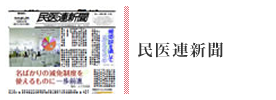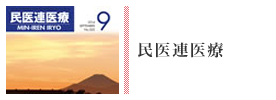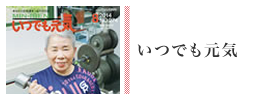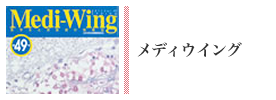english
2013年4月1日
Remembering 3.11: Doctors Continue to Support Disaster-Hit Communities
Almost two years have passed since the Great East Japan Earthquake and the accident at Fukushima Daiichi Nuclear Power Plant. We have now fewer and fewer news reports about the disaster-hit areas. We visited Saka Sogo Hospital of Shiogama City, Miyagi Prefecture, which served as the emergency headquarters for Min-Iren’s activities following the disaster.
Smiles on Children’s Faces
On that day, Dr. Kodama Takayuki was a medical student and was travelling abroad during the holidays after the school year was over. Wanting to be of help, he flew back home three days after the quake, and the next day, started to work as a volunteer at Saka Sogo Hospital.
He vividly remembers the smiles on the faces of children who played football together and said, “Please come back and play with us again.” From April that year he started the on-the-job training as the medical doctor and joined the health consultation activities at shelters and temporary housing complexes. “When I spoke to the people, their tense expression softened, which game me a great pleasure,” Dr. Kodama said with a smile.
Medical care to stand with victims
Dr, Yazaki Tomoko felt the earthquake at Furukawa Minshu Hospital in Osaki City. After engaging in an immediate response work, she hurried home in Shiogama City, as she was concerned about her children at a day-care center. Usually it was an hour’s drive, but it took her almost 5 hours to reach the center, where she learned that her children had safely been evacuated to the primary school nearby.
Next day, she was busy helping to feed the evacuees at the primal school, and went back to join Min-Iren’s emergency headquarters at Saka Sogo Hospital two days after the earthquake. At the hospital’s parking lot, there were already many cars of fellow Min-Iren workers from different parts of Japan outside Miyagi. “This shows Min-Iren’s solidarity power,” she was thrilled at this sight.
In visiting one of the emergency shelters, Dr. Yazaki met an elderly man who suffered heavy burns while being carried by the tsunami, due to contact with some chemical agent afloat. “Why did you not come to the hospital until the condition got this bad?” she asked him. “Hospitals should be the place where patients with severer conditions go, not me” the man replied. “Those who survived the tsunami have seen the seriously injured or dead just next to themselves. They tend to hide their pains or feelings, thinking that they were lucky enough to survive and able to walk and talk.” This experience made her realize the necessity of visiting the people staying at the shelters.
Dr. Yazaki worked day and night at the emergency headquarters. She was in charge of assigning supporters coming from across Japan to work in teams to visit shelters and of coordinating donated goods and articles.
Engaged in support activities with broken heart
One of Dr. Sato Miki’s relatives in Onagawa Town was carried away by the tsunami and still missing. She has come to blame herself for rejoicing at the survival of her own family members after she learned about the missing relative. On March 26 she gave birth to the third child, but due to the shock of the disaster she fell apathetic, and was not able to leave home except for going to/from the day-care center.
Entering May that year, she went with her children to Onagawa Town, where her relative used to live. After she prayed for the soul of the missing, she was gradually able to face the reality, and in June she returned to work. For a while she worked hard as if she tried to forget about the tragedy. But one day she was asked to give health consultation at a temporary housing complex.
At first she felt like she wanted to cover her ears to the tragic stories of the victims, but slowly she began to think, “Is there anything I could do for them?” She still has conflicted feeling about engaging with the disaster victims, fearing that she herself might feel devastated. But encouraged by her fellow workers she often goes to visit temporary housings in Onagawa Town and other shelters to help prepare hot meals. “I was afraid, but after all it was good to be there, since I was able to meet someone who knew my relative there, and people were happy with our effort,” Dr. Sato said, smiling.
Activities continue
Dr. Sato continues to be engaged in the support activities, coordinating the sales of aroma candles and tissue paper box covers created by the victims living in temporary housings.
Though the rehabilitation work is going on, she feels she should not forget about the nuclear power plant accident, which, even now, is far from being brought under control. Every time Dr. Yazaki gives a lecture on radioactivity or internal radiation exposure in different places in Miyagi, she always asks participants to sign the petition to oppose the reopening of Onagawa Nuclear Power Plant.
“Most information readily available tries to underestimate the damage from the nuclear accident, or to deny the damage on peoples’ health. But I urge our hospital staff and the members of Kyodo-soshiki to go out of their way to obtain correct information. And we must raise our voices to demand zero nuclear power plants,” Dr. Yazaki emphasized.
(Article by Yasui Keitaro; Photo by Noda Masaya)
 この記事を見た人はこんな記事も見ています。
この記事を見た人はこんな記事も見ています。









